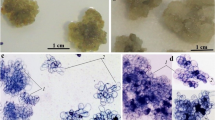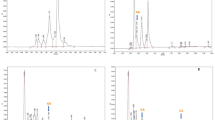Abstract
Callus and suspension cultures ofAntennaria microphylla (small everlasting) and the noxious weedEuphorbia esula (leafy spurge) can glucosylate benzene-1,4-diol (hydroquinone) to the corresponding monoglucoside, arbutin. HPLC analysis of extracts from callus tissue corroborates the presence of hydroquinone in the cells of small everlasting. Constitutive levels of a UDPG-dependent glucosyltransferase were detected in cell-free extracts of this tissue. Although this detoxification enzyme was induced in leafy spurge suspension culture cells grown in the presence of hydroquinone, the activity was six-fold lower than that measured in small everlasting. Differential ability to detoxify hydroquinone provides a basis for the observed allelopathic interaction between small everlasting and leafy spurge.
Similar content being viewed by others
References
Anderson, J.D. andHough, L. 1960. The reaction of carbohydrases with phenolic glucosides.Biochem. J. 77:564–567.
Bradford, M.M. 1976. A rapid and sensitive method for the quantitation of microgram quantities of protein utilizing the principle of protein-dye binding.Anal. Biochem. 72:248–254.
Davis, D.G., Wergin, W.P., andDusbabek, K.E. 1978. Effects of organic solvents on growth and ultrastructure of plant cell suspensions.Pestic. Biochem. Physiol 8:84–87.
Glass, A.D.M., andBohm, B.A. 1971. The uptake of simple phenols by barley roots.Planta 100:93–105.
Hogan, M.E., andManners, G.D. 1990. Allelopathy of small everlasting (Antennaria microphylla) to leafy spurge (Euphorbia esula) in tissue culture.J. Chem. Ecol. 16(3):931–939.
Kleinhofs, A., Haskins, F.A. andGorz, H.J. 1967. Trans-o-hydroxycinnamic acid glucosylation in cell-free extracts ofMelilotus alba.Phytochemistry 6:1313–1318.
Manners, G.D. 1987. The role of phytochemistry in attacking the leafy spurge (Euphorbia esula) problem, pp. 228–237, in G.R. Waller (ed.). Allelochemicals: Role in Agriculture and Forestry. ACS Symposium Series 330. American Chemical Society, Washington, DC.
Manners, G.D., andGalitz, D.S. 1985. Allelopathy of small everlasting (Antennaria microphylla): Identification of constituents phytotoxic to leafy spurge (Euphorbia esula).Weed Sci. 34:8–12.
Miles, C.D., andHagen, C.W. 1968. The differentiation of pigmentation in flower parts, IV. Flavanoid elaborating enzymes from petals ofImpatiens balsamina.Plant Physiol. 43:1347–1354.
Pridham, J.B. 1964. The phenol glucosylatin reaction in the plant kingdom.Phytochemistry 3:493–497.
Pridham, J.B., andSaltmarsh, M.J. 1963. The biosynthesis of phenolic glucosides in plants.Biochem. J. 87:218–224.
Suzuki, T., Yoshioka, T., Tabata, M., andFujita, Y. 1987. Potential ofDatura innoxia cell suspension cultures for glucosylating hydroquinone.Plant Cell Rep. 6:275–278.
Tabata, M., Ikeda, F., Hiraoka, N., andKonoshima, M. 1976. Glucosylation of phenolic compounds byDatura innoxia suspension cultures.Phytochemistry 15:1225–1229.
Tabata, M., Umetani, Y., Ooya, M., andTanaka, S. 1988. Glucosylation of phenolic compounds by plant cell cultures.Phytochemistry 27(3):809–813.
Takiura, K., Yamamoto, M., Miyaji, Y., Takai, H., Honda, S., andYuki, H. 1974. Studies of oligosaccharides. XV. Syntheses of hydroquinone glycosides of gentio oligosaccharides.Chem. Pharmacol. Bull. 22(10):2451–2454.
Ushiyama, M., andFuruya, T. 1989. Glucosylation of phenolic compounds by root culture ofPanax ginseng.Phytochemistry 28(11):3009–3013.
Yamaha, T., andCardini, C.E. 1960a. The biosynthesis of plant glycosides. I. Monoglucosides.Biochim. Biophys. Acta 86:127.
Yamaha, T., andCardini, C.E. 1960b. The biosynthesis of plant glycosides. II. Gentiobiosides.Biochim. Biophys. Acta 86:133–137.
Author information
Authors and Affiliations
Rights and permissions
About this article
Cite this article
Hogan, M.E., Manners, G.D. Differential allelochemical detoxification mechanism in tissue cultures ofAntennaria microphylla andEuphorbia esula . Journal of Chemical Ecology 17, 167–174 (1991). https://doi.org/10.1007/BF00994430
Received:
Accepted:
Issue Date:
DOI: https://doi.org/10.1007/BF00994430




